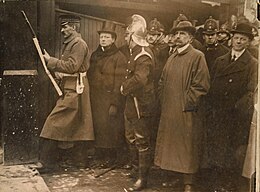
Back حصار شارع سيدني Arabic Setge de Sidney Street Catalan Belagerung der Sidney Street German Sitio de Sidney Street Spanish Sidney Streeti piiramine Estonian محاصره خیابان سیدنی Persian Sidney Streetin piiritys Finnish Siège de Sidney Street French Léigear Sidney Street Irish Սիդնեյ սթրիթի պաշարում Armenian

The siege of Sidney Street of January 1911, also known as the Battle of Stepney, was a gunfight in the East End of London between a combined police and army force and two Latvian revolutionaries. The siege was the culmination of a series of events that began in December 1910, with an attempted jewellery robbery at Houndsditch in the City of London by a gang of Latvian immigrants which resulted in the murder of three policemen, the wounding of two others, and the death of George Gardstein, a key member of the Latvian gang.
An investigation by the Metropolitan and City of London Police forces identified Gardstein's accomplices, most of whom were arrested within two weeks. The police were informed that the last two members of the gang were hiding at 100 Sidney Street in Stepney. The police evacuated local residents, and on the morning of 3 January a firefight broke out. Armed with inferior weapons, the police sought assistance from the army. The siege lasted for about six hours. Towards the end of the stand-off, the building caught fire; no single cause has been identified. One of the agitators in the building was shot before the fire spread. While the London Fire Brigade were damping down the ruins—in which they found the two bodies—the building collapsed, killing a fireman.
The siege marked the first time the police had requested military assistance in London to deal with an armed stand-off. It was also the first siege in Britain to be caught on camera, as the events were filmed by Pathé News. Some of the footage included images of the Home Secretary, Winston Churchill. His presence caused a political row over the level of his operational involvement. At the trial in May 1911 of those arrested for the Houndsditch jewellery robbery, all but one of the accused were acquitted; the conviction was overturned on appeal. The events were fictionalised in film—in The Man Who Knew Too Much (1934) and The Siege of Sidney Street (1960)—and novels. On the centenary of the events two tower blocks in Sidney Street were named after Peter the Painter, one of the minor members of the gang who was probably not present at either Houndsditch or Sidney Street. The murdered policemen and the fireman who died are commemorated with memorial plaques.
© MMXXIII Rich X Search. We shall prevail. All rights reserved. Rich X Search